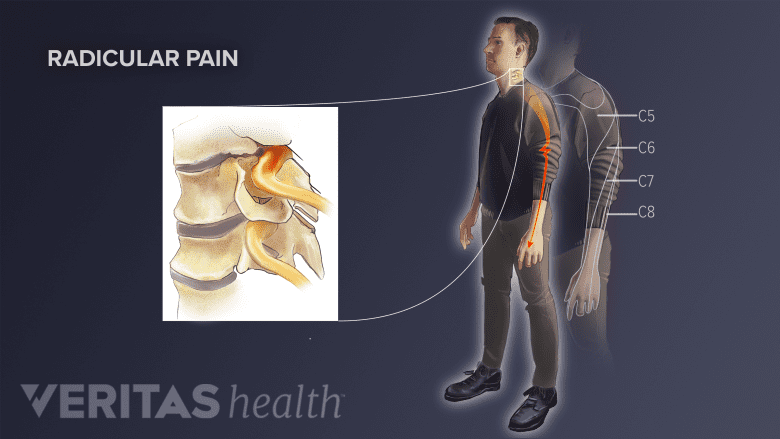Along the entire length of the spine, the spinal nerves exit through spaces (foramen) between the bones forming each motion segment of the spine.
These nerves are called nerve roots. They branch out to the right and left of the spine and innervate parts of our body.
The nerve pain and / or neurological symptoms that result from a problem with a spinal nerve is usually described as sharp, burning, searing, or as a sensation such as cold or icy, prickly, numbness, pins and needles, or weakness.

Nerve roots branch directly from the spinal cord and merge to form the spinal nerve as it runs through an opening between adjacent vertebrae, called the intervertebral foramen.
Radicular Pain
Radicular pain is the diagnosis for pain that starts at the nerve root in the spine and radiates along the path of a spinal nerve.
It is typically caused by compression or irritation of the nerve root as it exits the spinal column. Radicular pain does NOT cause weakness or numbness.
Radicular stems from the Latin term radix, which means “root”. The nerve root is affected by a problem in the spine.
- “Radic” – means root (nerve root)
- “Ular” – means relating to
So radicular pain means pain related to the nerve root.
Radiculitis
Radiculitis is a synonym for radicular pain and all its features, as described above are the same.
The term originates from:
- “Radic” - means root (and refers to the nerve root)
- “Itis” - in medicine describes a disease characterized by inflammation
Like radicular pain, radiculitis can occur when a disc herniates and the inflammatory proteins contained in the inner contents of the spinal disc irritate the nearby nerve root and cause an inflammatory response.
Other lumbar spinal problems can cause this type of inflammation in and around the nerve root, such as lumbar spinal stenosis or spondylolisthesis.
Rarely, lumbosacral radiculitis can be caused by issues other than a spinal condition. For example:
- Radiculitis can be caused by a virus, called viral radiculitis or Elsberg Syndrome. This usually occurs due to a herpes simplex virus 2 (HSV2) infection. In very severe cases, it can involve the spinal cord and cause cauda equina syndrome.1Filippo Savoldi, MD, Timothy J. Kaufmann, MD, Eoin P. Flanagan, MBBCh, Michel Toledano, MD, and Brian G. Weinshenker, MD. Elsberg syndrome. A rarely recognized cause of cauda equina syndrome and lower thoracic myelitis. 5/11/2017. https://doi.org/10.1212/NXI.0000000000000355
- Another less common cause of lumbosacral radiculitis is shingles. This can occur if the shingles occurs near a nerve root and causes inflammation.2Abhinav R. Changa, MD and Rajan Jain, MD. Herpes zoster lumbar radiculitis. 8/5/2020. https://doi.org/10.1212/WNL.000000000001058
Radiculopathy
Radiculopathy is best defined as the complex of the neurological signs of radicular nerve pain but always includes a neurological loss such as weakness, numbness, and/or loss of a deep tendon reflex.
The term originates from:
- “Radic” - means root (and refers to the nerve root)
- “Pathos” – the Greek work for suffering from
Radicular Pain and Radiculitis vs. Radiculopathy
Many sources include pain in the definition of radiculopathy, rather than separate out radicular pain from radiculopathy. Other sources use the terms interchangeably.
However, the medically accurate definitions of radicular pain, radiculitis and radiculopathy are:
- Radicular pain or radiculitis involves only the perception of neurological loss such as weakness, numbness, and/or loss of a deep tendon reflex
- While radiculopathy ALWAYS involves some form of neurological loss as described above and may also include sensations associated with radicular pain or radiculitis.
Cervical and Lumbar Radicular Symptoms
The symptoms of nerve root problems in the cervical spine (neck) or lumbar spine (low back) cause symptoms to radiate into the connected areas:
- Nerves that exit the cervical spine travel down through the arms, hands, and fingers. This is why neck problems that affect a cervical nerve root can cause pain and other symptoms through the arms and hands (radicular pain, radiculitis and/or radiculopathy).
- The nerves that exit the lumbar spine travel down through the buttock, leg, foot and toes. This is why an issue in the lower back that affects a lumbar nerve root can radiate pain and/or nerve deficits in the leg and into the foot. Pain that radiates down the leg is commonly referred to as sciatica.
The nerve roots are named for the level of the spine at which they exit. However, nerve roots are not labeled consistently throughout the length of the spine.
In the cervical spine, the nerve root is named according to the LOWER spinal segment that the nerve root runs between.
For example, the nerve at the C5-C6 level is called the C6 nerve root. It is named this way because as it exits the spine the nerve root passes OVER the C6 pedicle (a piece of bone that is part of the C6 vertebra).
In the lumbar spine, the nerve roots are named according to the UPPER segment that the nerve runs between.
For example, the nerve root at the L4-L5 level is called the L4 nerve root. The nerve root is named this way because as it exits the spine it passes UNDER the L4 pedicle (a piece of bone that is part of the L4 vertebra).
The area that the naming change occurs is at the C7-T1 level (Thoracic 1), meaning that there are 8 cervical nerve roots and only seven cervical vertebrae.
At the C7-T1 motion segment, the C8 nerve exits UNDER the C7 vertebra and OVER the T1 vertebra.
From this point down through the upper back, lower back and sacral region, the nerve is named for the upper segment of the spine that the nerve root runs between (and the pedicle it passes UNDER as it exits the spine).
This is part of the picture. However, your doctor may still say that you have a problem with the L5 nerve root at the L4-L5 level. Since we just explained that the L4 nerve root exits at the L4-L5 level, this sounds like a contradiction.
However, as you will see blow both statements are correct, and can be explained by the fact that there are two nerve roots at each level.
Two Nerve Roots at Each Level
It should be mentioned that two nerves cross each disc level but only one exits the spine (through the foramen) at each level.
Exiting nerve root. The nerve root that exits the spine at a particular level is referred to as the “exiting” nerve root.
Example: The L4 nerve root exits the spine at the L4-L5 level.
Traversing nerve root. The other nerve root that passes further downward and exits at the next lower spinal level is called the “traversing” nerve root.
Example: The L5 nerve root is the traversing nerve root at the L4-L5 level, and is the exiting nerve root at the L5-S1 level.
A lot of confusion occurs because when a nerve root is compressed by disc herniation or other cause, it is common to refer both to the intervertebral level (where the disc is) and to the nerve root that is affected.
Depending on where the disc herniation or protrusion occurs, it may impinge upon either the exiting nerve root or the traversing nerve root. For example:
When the traversing nerve root is affected
Lumbar radiculopathy. In the lumbar spine, there is a weak spot in the disc space that lies right in front of the traversing nerve root, so lumbar discs tend to herniate or leak out and impinge on the traversing nerve root.
For example:
A typical posterolateral (behind the disc and to the side) lumbar disc herniation at the L4-L5 level often affects the nerve that traverses the L4-L5 level and exits at the L5 level, called the L5 nerve root.
Most cases affect the nerve root that exits below the lumbar spinal motion segment L4-L5 (the L5 nerve root) or the L5-S1 (the S1 nerve root).
When the exiting nerve root is affected
Cervical radiculopathy. In the cervical spine, the disc tends to herniate to the side (laterally), rather than toward the back and the side (posterolaterally). If the disc material herniates to the side, it would likely compress the exiting nerve root.
For example:
The C6 nerve root would be affected at the C5-C6 level (because in the neck the exiting nerve root is named for the level below it).
Watch Cervical Radiculopathy Video
Because the spinal canal is usually fairly spacious in the low back, and because the spinal cord ends at L2 and its individual nerves branch out as the cauda equina travelling separately downward, problems in the lumbosacral region (the lumbar spine and sacral region of the spine) usually cause individual nerve root problems, not spinal cord injury and resulting paralysis.
- 1 Filippo Savoldi, MD, Timothy J. Kaufmann, MD, Eoin P. Flanagan, MBBCh, Michel Toledano, MD, and Brian G. Weinshenker, MD. Elsberg syndrome. A rarely recognized cause of cauda equina syndrome and lower thoracic myelitis. 5/11/2017. https://doi.org/10.1212/NXI.0000000000000355
- 2 Abhinav R. Changa, MD and Rajan Jain, MD. Herpes zoster lumbar radiculitis. 8/5/2020. https://doi.org/10.1212/WNL.000000000001058

